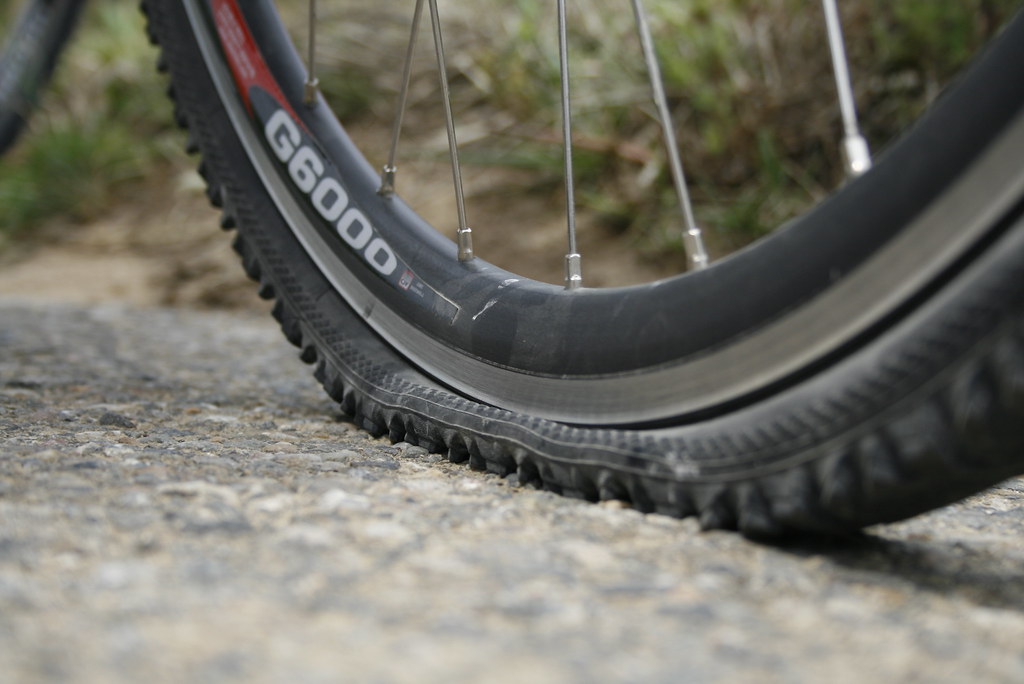Tire care is an essential skill for any rider, from perfecting the art of fixing punctures using repair kits to alternate ways for urgent repairs. It is, therefore, crucial to know how to fix a flat bike tire.
Learn how to fix a flat bike tire and the need for spare tubes in emergency scenarios. Explore the effects that temperature and tire conditions have on progressive air loss.
This complete guide prepares cyclists with the knowledge to overcome flat tire challenges and maintain an uninterrupted journey on two wheels, with methods that go from patching to prevention.
Educate yourself with these techniques to confidently overcome unexpected flats and enjoy a smooth ride on every journey.
Tools Required
The following items should be carried with you at all times in case you need to repair a flat tire on your bicycle:
- Tire Levers are used to safely remove tires during tube repair.
- Patch Repair Kit for quickly repairing punctures on the go.
- Pump for inflation after patching for a smooth ride.
How To Fix a Flat Bike Tire?
Here are the five basic steps for fixing a flat bicycle tire:
1. Remove Wheel
Front Wheel
Check that your bike is securely positioned upside down. Begin by releasing the quick-release lever or loosening the axle nuts on the front wheel. Lift the wheel gently off the fork, being careful not to damage any components. This makes tire maintenance simpler.

Rear Wheel
To disengage the back wheel, loosen the tension on your chain by shifting it to the smallest gear. Remove the wheel from the frame after releasing the brakes. This method makes it easier to remove the tire from the back wheel.
2. Remove Tube
With the wheel removed, gently push the tire bead away from the rim with tire levers. Begin at the other end of the valve stem and work your way around. When one side of the bead is loose, carefully take out the inner tube while taking care not to damage the valve stem.
3. Find Cause of Flat
To make the puncture more visible, slightly inflate the tube. Look for hissing sounds that indicate leaking air. Also, make a solution of water and mild soap and apply it to the surface of the tube. Look for bubbles appearing where the air is escaping to locate the exact spot of puncture.

4. Patch Tube
Using a patch repair kit to fix a flat tire tube is a simple but necessary skill for cyclists. Roughen the area surrounding the puncture using the provided sandpaper, then apply glue and let it get thick. Apply a patch firmly to ensure a strong binding.
After the sealant has dried, reinsert the tube, line the bead, and gradually inflate the tire. This procedure ensures a reliable repair, allowing you to quickly resume your bicycle ride with confidence.
5. Reinstall Wheel
Front Wheel
Align the tire wall with the rim, starting opposite the valve stem. Working your way around the wheel, gently push the bead onto the rim. To avoid pinching, ensure that the tube is evenly tucked into the tire.
Rear Wheel
Slide the back wheel into the frame after attaching the chain to the smallest gear. Reinstall the chain to the gear, making sure it’s firmly placed. Secure the axle bolts or quick-release lever, and check that the brakes work properly.
Inspect all components that have been adjusted to verify that everything is tight and back where it belongs. Check if your tire pressure is enough, your brakes are operational, and all levers are closed and folded back into their riding positions. After that, you’re all set!
How to Fix a Tubeless Tire?
This simple guide includes the necessary steps to quickly fix your tubeless tire and get you back on the road.

1. Locate Leak
Start by softly inflating the tire and listening for any hissing noises. Then, apply a soapy water mixture to the tire’s surface and look for bubbles whether air is escaping. It helps in determining the exact position of the puncture.
2. Inspect & Clean
Remove the tire off the rim, allowing all air from the bead to escape. Inspect the tire’s inside and outside completely. Check for any sharp items or debris that may have been stuck in the tire, which might result in another puncture.
3. Apply Patch
If you have a tubeless tire plug kit, place the plug from the outside into the puncture, making sure it’s firmly and thoroughly planted. Trim away any surplus plug material so that it is level with the tire surface. The stopper creates an airtight seal that prevents air from escaping.
4. Reinflate & Confirm Seal
If the valve stem was removed before, replace it and inflate the tire to the required pressure. Check for signs of air leaking when you spin the tire. The hissing sound of escaping air will be gone if the seal is successful.
5. Monitor During & After Riding
Before starting your ride, inspect the patched tire to confirm the seal is still intact. As you ride, keep an eye on the tire’s performance, paying attention to any odd changes in pressure or handling.
How to Fix a Flat Bike Tire with Household Items?
When you have a flat bike tire and no specialist tools, you may still get back on the road by utilizing common home goods. Begin by using a water and soap solution to locate the leak, then remove and check the tube for damage or debris.

If you have a patch kit, repair the puncture according to the directions. In the absence of a kit, consider covering the hole with temporary materials such as duct tape or folded banknotes.
Reassemble the wheel and inflate the tire to the right pressure after gently reinserting the tube. While domestic solutions are only temporary, they can help you keep riding until a more permanent repair can be made.
What Causes Bike Tires to Go Flat?
Flat bike tires could ruin your cycling plans, but understanding the main causes can save the day. Understanding the sources of road debris or maintenance mistakes is critical for prevention.
Here’s an overview of the most common causes of flat bike tires:
- Insufficient tire pressure increases the likelihood of pinch flats, especially on uneven terrain or after an incident.
- Tires can be punctured by small things such as glass, spikes, or gravel, resulting in leaks or blowouts.
- Tubes that are not correctly placed produce friction, which leads to premature wear and flats.
- Rims that are bent or damaged impose uneven pressure on tubes, resulting in punctures.
- Thin treads provide less protection against debris and increase puncture risk.
- Extreme weather changes influence tire pressure, which can lead to flat tires.
- Tubes and tires degrade with time, making them more prone to punctures.
- Leaks or unexpected blowouts are caused by improperly seated valves.
Should You Replace Or Repair a Damaged Tube?

When faced with a broken bike tube, the decision between repair and replacement is influenced by several factors. Examine the extent and kind of damage; tiny punctures can often be repairable using patch kits.
Consider the tube’s age, wear, and overall condition—older or heavily worn tubes may need to be replaced. Consider your skill level and available repair tools, as well as the riding conditions you normally experience.
Multiple punctures around the tube may undermine its structural strength, preferring replacement. Furthermore, emphasize safety; heavily repaired or seriously fractured tubes could compromise the security of your journey. Finally, consider the cost-effectiveness, convenience, and long-term viability of your selected option.
How To Prevent Flat Bike Tires?
Here are some great tips for avoiding flat bike tires:
Choose High-Quality Tires
Investing in premium quality tires with puncture-resistant technology can minimize the likelihood of flat tires considerably. Look for alternatives that are built to handle a variety of road conditions, such as those with stronger sidewalls and long-lasting tread patterns.
Maintain Proper Tire Pressure

Check and maintain the correct tire pressure for your bike regularly. Appropriate tire pressure not only avoids flats but also improves the whole riding experience by improving stability and handling.
Inspect Tires Before Each Ride
Before you leave, check your tires for debris, sharp objects, or visible damage. Remove any possible hazards. Such as broken glass or thorns, to prevent them from puncturing the tire.
Install Tire Liners or Sealant.
Consider utilizing tire liners or sealant solutions to provide an extra layer of protection against punctures. Tire liners are placed between the tube and the tire, whereas sealants can rapidly seal tiny punctures, allowing you to continue your ride uninterrupted.
Avoid Risks
Keep away from road debris, broken glass, potholes, and other possible dangers while riding. When riding, be aware of your surroundings and avoid high-risk areas to prevent punctures.
Conclusion
No matter how casual or serious a cyclist may be, it is a necessity to learn how to fix a flat bike tire. The ability to fix and manage flat tires expertly can reduce a potential setback to a little glitch.
The article included a comprehensive view of tire-related problem-solving, from utilizing repair kits to learning on-the-go solutions. Taking into account the intricacies of progressive air loss and the importance of tire quality guarantees that each pedal stroke is effective and pleasurable.
This guide opens the path for continuous journeys and a better appreciation for the art of two-wheeled adventure by providing cyclists with the skills to tackle flat tire conditions.
FAQs
Remove the damaged tube from the flat bike tire, replace it with the spare tube, and then re-inflate it.
Mountain bike flat tires are repaired by removing the wheel, finding the puncture, patching it, reinserting the tube, and reattaching the wheel.
Superglue should never be used to patch or repair a puncture in a tire or its inner tube.
Bike tires normally lose 1-2 psi of air every week. Temperature, tire quality, and valve condition can all have an impact on the rate of air loss.



